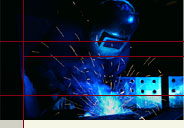
This is my version of the carbon canister removal and bypass for a 1992 Nissan 300ZX twin turbo. I did this job back in January 2004 and have no bad effects to report. Please review this site's Disclaimer before reading any further.
I make no claims that this is the best and only way to accomplish this mod, other than I practiced due diligence in my research and pass on the info in good faith. You can skip directly to the “How To” section if you just want the nuts and bolts part of the explanation. I can not comment on this job for the non-turbos (NA’s = normal aspiration) other than to say that I think the job should be easier with the intercoolers out of the way.
What is the carbon canister?
Cars have three main sources of air pollution, along with the federally mandated systems installed to reduce these emissions. First, the crankcase emissions are returned to the engine by the positive crankcase ventilation (PCV) system. Second, the tailpipe exhaust emissions are controlled mainly by the exhaust gas return (EGR) system, the catalytic converters, and by electronic control unit adjustments (ECU) to the engine.
Finally, fumes from the gas tank are sealed from the atmosphere by the gas cap at the fuel filler, and stored in a carbon canister (CC) for reburning when the engine is running. The CC, gas cap, lines and controls are sometimes collectively referred to as the EVAP (evaporative) system. A car’s EVAP system is passive. The gas fumes are trapped in the carbon canister while the car is at rest, then purged back into the intake system using vacuum pressure when the car is running.
In the z32, the carbon canister (CC) is located in the driver’s side (DS) fender well, behind the stock intercooler (IC). The CC does not affect performance or exhaust emissions in any way.
If you have a 1996 Z, read the tech section at the end.
Why remove the carbon canister?
Weight reduction is minimal, the canister only weighs a few pounds, but with the heavy Z, every little bit helps. As a potential source of vacuum leaks, there are several separate rubber lines and even the plastic canister itself can crack with age. A failed, damaged or clogged canister is a known cause for the engine to run poorly. Eliminating unnecessary vacuum lines also simplifies future trouble shooting and maintenance.
The canister sits right behind the DS IC. Removing the CC improves airflow around the DS IC, which would yield a theoretical performance benefit.
Eliminating the CC does mean there will theoretically be some fumes vented to the atmosphere. The instructions here are for discussion purposes only, and not intended as a recommendation or endorsement to doing anything to your car that will increase air pollution. A malfunctioning gas cap would release much more hydrocarbons into the atmosphere than the CC bypass as described here.
When to do it?
Whenever the front fascia (FF) is off, or whenever a problem is suspected with the system. There is a temporary diagnostic bypass procedure in the tech section near the end of this article. I had a new pair of Greddy side mounted IC's to install. This was the perfect time to remove the CC, and improve air flow around the driver side IC at the same time.
Tool needed
Simple hand tools, 10mm socket, curved long needle nose pliers, sharp knife, a one foot section of 6mm vacuum line (I prefer silicone), a few vacuum plugs or you can make your own.
Difficulty
If the front fascia is already off, then a 2 out of 5. Time is about an hour, again, not counting the labor to remove the FF.
How to do it
Removing the front fascia is the hardest part, and it is not that hard although it helps to have two sets of hands.
After the FF and DS intercooler are removed, you will see the black, cylindrical CC in the wheel well looking like the photo below. My stock IC’s were being swapped for aftermarket ones. I do not know if the job is possible while leaving the IC in. Pulling the IC is not hard, and doing so yields a lot of room to work, so I recommend it.
Ignore the red overspray paint :c) That’s what happened with a sorry-ass FF paint job. The large black open hose to the left is the IC inlet hose. The white plastic tank on the right edge is the radiator overflow tank. There is a slice of the IC outlet hose in seen in the bottom, right corner. So if the IC were in place, the airflow would flow from left to right in this picture.
There are four lines connected to the top of the tank, and one large hose that splits into two coming out of the bottom. Once the canister and all the hoses are removed, the green arrows show the new connection you will make with about a one-foot section of six-millimeter vacuum hose. The green dot shows a vacuum nipple that must be capped. Everything else can be left open.
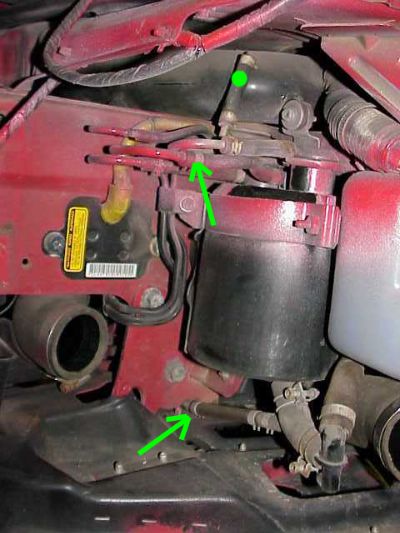 Remove the single bracket bolt holding the circular, metal retaining strap around the CC. The bolt is a tight fit because of the overflow tank, so I loosened the nearest mounting bolt on the radiator overflow tank, too. Remove the single bracket bolt holding the circular, metal retaining strap around the CC. The bolt is a tight fit because of the overflow tank, so I loosened the nearest mounting bolt on the radiator overflow tank, too.
Slide the clamps off that are holding the hoses onto the CC, with the curved needle nose pliers. There is only one hard line you have to identify, and that is the "fuel tank" line on top. Mark or tag it somehow, or later you can blow in it with your gas cap off and confirm there are bubbling sounds coming out of the gas tank inlet. Do not blow into this line with a full tank of gas, otherwise gas will overflow onto your garage floor.
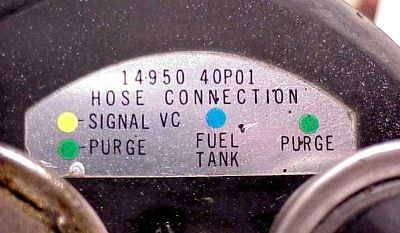 The four connections on the top of the CC are labeled TWICE on the canister. First, as a decal on the top surface as shown here, The four connections on the top of the CC are labeled TWICE on the canister. First, as a decal on the top surface as shown here,
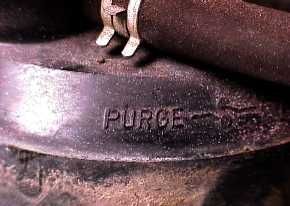 and again on the side of the CC where the writing is molded onto the tank. and again on the side of the CC where the writing is molded onto the tank.
You only have to identify the fuel tank line. On my car, a ’92 TT, the fuel tank vent line was the most outboard line coming off the three hard lines of the metal galley.
Remove or cut all the rubber hoses off, bend the bracket open and pry out the CC. Finish removing the CC mounting bracket by removing the three,10mm bolts that hold it onto the frame rail. Remove all the remaining hoses that were connected to the CC. The large bottom hose from the canister splits into two. Note where the bottom small hose disappears into the frame rail. This will be the connection for the fuel tank vent line from above, if your car has this bottom connection. If not, do not worry.
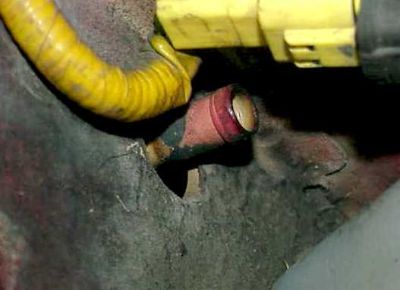 The large, bottom tube from the CC continues up high and connects behind the CC into the frame rail, onto the this metal tube shown here. The large, bottom tube from the CC continues up high and connects behind the CC into the frame rail, onto the this metal tube shown here.
If your car did not have the small tube shown at the lower green arrow four pics above, you can instead thread the fuel line with some silicone hose into here, or to some other out-of-the-way place under the car. All you are trying to do is vent fuel vapors that may exist at the end of the fuel line that was connected to the CC. I do not recommending capping the fuel line, as this is the only vent for the tank when the car sits.
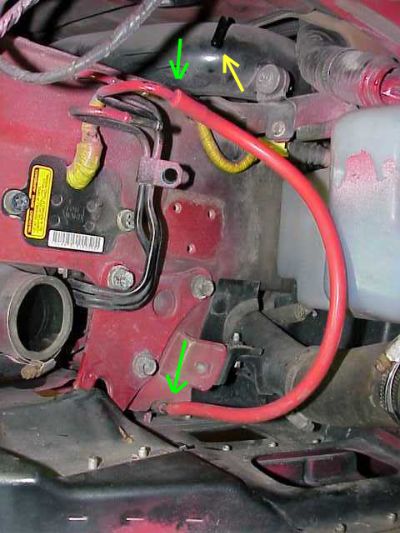 Here is the overall view with the CC removed and the fuel vent line rerouted with a red vacuum hose. The new connections are shown by the green arrows. Leave some slack for the IC that installs in front of the red hose. The yellow arrow shows an open nipple on the air intake tube that that must be capped, shown two pics below. Here is the overall view with the CC removed and the fuel vent line rerouted with a red vacuum hose. The new connections are shown by the green arrows. Leave some slack for the IC that installs in front of the red hose. The yellow arrow shows an open nipple on the air intake tube that that must be capped, shown two pics below.
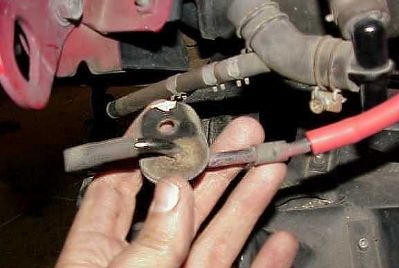 I unbolted the connection at the lower green arrow just to show how the line ends in a small rubber flap bleeder valve. I unbolted the connection at the lower green arrow just to show how the line ends in a small rubber flap bleeder valve.
Remember, the bottom connection is not critical. Many peeps have E-mailed me that their car did not have this place to connect the line. Then just vent that end of the line into the frame rail or under the car. Rimes E-mailed me and said that he put a one-way valve from a windshield washer squirter at the end of this line with good results.
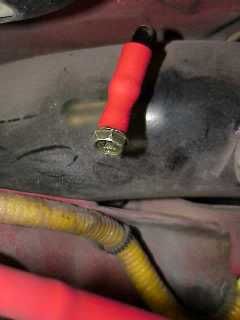 I didn’t feel like making a run to the auto parts store just for a vacuum cap, so I made a vacuum cap for the air intake tube by putting a screw in short piece of vacuum hose, as shown. From the overkill department, I used sealant around the screw threads and put a plastic cable tie around the hose after the pic was taken. I didn’t feel like making a run to the auto parts store just for a vacuum cap, so I made a vacuum cap for the air intake tube by putting a screw in short piece of vacuum hose, as shown. From the overkill department, I used sealant around the screw threads and put a plastic cable tie around the hose after the pic was taken.
You can get to this cap in the future by removing the two screws that attach the driver side turn signal light, so it's no big deal. Otherwise it is hidden and will not show even from the engine bay, in case you have a show car or are worried about the appearance. The work is now done in the driver side fender well.
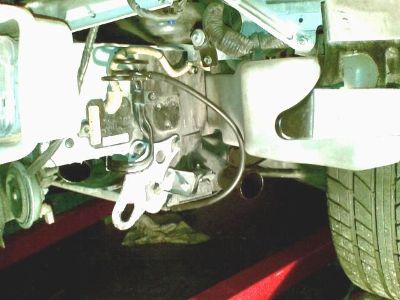 Here is a more distant view of the bypass on a 91 TT, sent in by Travis. Intercooler was removed for pic. The bypass hose is black. Here is a more distant view of the bypass on a 91 TT, sent in by Travis. Intercooler was removed for pic. The bypass hose is black.
Time to move under the hood.
Remove the two, large intercooler hoses on the DS, shown by the green dots in the photo. These hoses are lot easier to remove when warm. You can either run the engine or warm the hoses with a hairdryer, if necessary. Each hose has two clamps holding it in place.
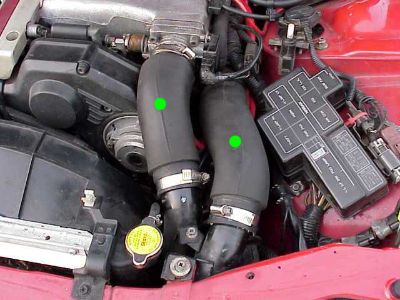
Now look down toward the front of the car, just outside of where the large IC hose ran from the turbo down to the IC. Find the metal vacuum galley as shown.
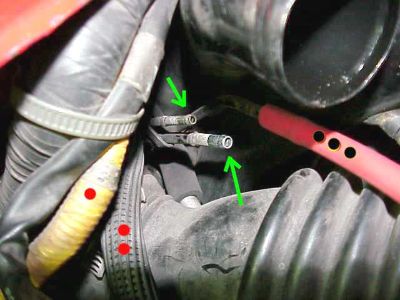 The line with the two red dots is the fuel vent line. See the section below on how to remove the leftover hardline "tree" if having open nipples under the hood bugs you. The line with the two red dots is the fuel vent line. See the section below on how to remove the leftover hardline "tree" if having open nipples under the hood bugs you.
Pull the two vacuum lines that were connected to the nipples shown by the green arrows. You can leave these nipples open because they aren’t connected to anything in the DS fender well any more. The top, open nipple was connected to the throttle body, the bottom nipple to the balance tube. The vacuum marked with the three black dots goes to the recirculation valve on the DS, so leave that untouched.
The line with the corrugated padding marked with the two red dots is the fuel vent line. That is the line that was left hooked up in the DS fender well, so leave that one alone, too.
The yellow line with the single red dot is part of the electronics to the supplemental restraint system (SRS) otherwise known as the air bag system. Definitely don’t touch that.
Next trace back to where the vacuum lines are connected under the hood. The top line went underneath the driver side throttle body (TB), which is very easy to see because you already have the IC hose removed. Put a vacuum cap on this nipple. I used a 3/16 size with some RTV silicone and it fit nicely.
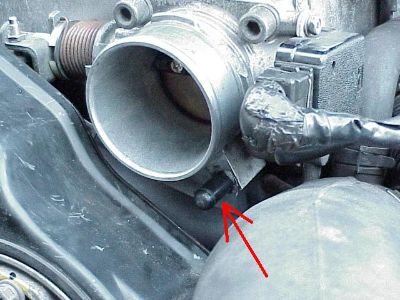 This nipple was later cut off and the hole was tapped with a bolt. This nipple was later cut off and the hole was tapped with a bolt.
The bottom vacuum line went to the back of the engine and connected to this nipple on the balance tube.
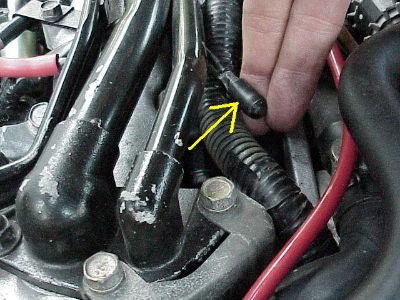 If not capped, this nipple makes a nice connection to the near by boost sensor, or for hooking up an aftermarket boost gauge. If not capped, this nipple makes a nice connection to the near by boost sensor, or for hooking up an aftermarket boost gauge.
Reinstall the large IC hoses and you’re done. Your car should run now. If you blew a lot of air into the fuel vent line it might take a few tries to start your car. Start your car before putting the FF back in place, in case you find any leaks that need immediate attention.
A small broup of peeps have contacted me over the years stating that they had a fuel smell immediately after doing the CC removal. I can think of a couple of issues. One is where the fuel vent line hook-up ended. Peeps have written me that their Z did not have the bleeder valve or hookup shown above for the fuel vent line, and they ended up venting the line in a bad place instead, such as under the hood. This could cause some fuel odor.
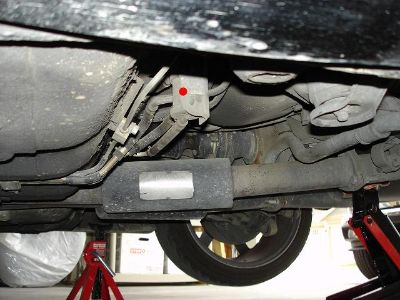 There is a fuel vapor vent line check valve behind the gas tank, on the driver's side, shown under the red dot. A plastic cover has to be removed on order to gain access to it. There is a fuel vapor vent line check valve behind the gas tank, on the driver's side, shown under the red dot. A plastic cover has to be removed on order to gain access to it.
Although I have never had an issue with this valve, one person wrote me this was the source of their fume smell after removing their CC. Nine times out of ten, any gas smell has nothing to do with the CC removal, and is due to a loose fuel line clamp somewhere else under the hood.
I did this job in January 2004 and so far have no problems or glitches to report. My gas cap still makes the familiar "whoosh" sound when opened, so the tank has maintained pressure after the CC delete.


After the CC is removed according to the above instructions, there will still be the hardline tree going from the engine bay down to where the CC used to be. Only one of these hardlines is still needed, to vent the fuel line as shown with the two red dots. The other two hard lines at the green arrows can be left open since they are no longer connected to anything. This bugged some people, and sometimes begged the question from the casual observer as to what should be connected to the open hardlines? Open vacuum lines could also catch some unwanted attention during inspection time. This section shows how to delete the entire hardline tree.
The insulated line under the white circle in the pic below is the same insulated line in the above pic, just below the open nipples. Trace that line forward to find a bolt that goes inside the white circle.
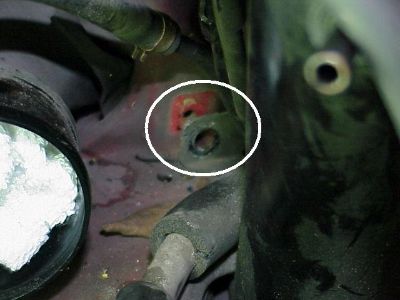 Bernie called this bolt the second hardest bolt to get to on any Z, but with an extension and universal joint he had it out in short time. Bernie called this bolt the second hardest bolt to get to on any Z, but with an extension and universal joint he had it out in short time.
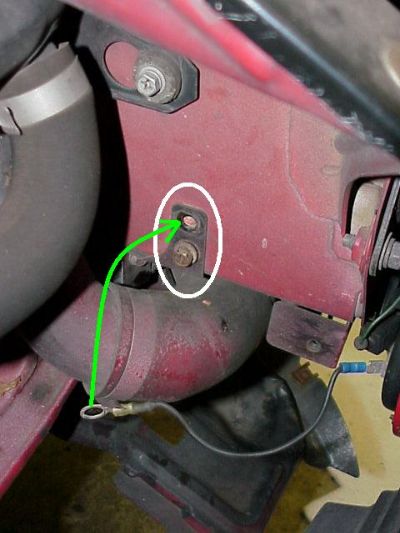 Nose panel is off, front fascia is on, splash shield underneath is removed. Inside front driver side frame rail, near the bumper, two bolts holding the hardlines need to be removed. The top bolt was also the ground for my aftermarket driver side horn, so obviously this bolt went back in. Nose panel is off, front fascia is on, splash shield underneath is removed. Inside front driver side frame rail, near the bumper, two bolts holding the hardlines need to be removed. The top bolt was also the ground for my aftermarket driver side horn, so obviously this bolt went back in.
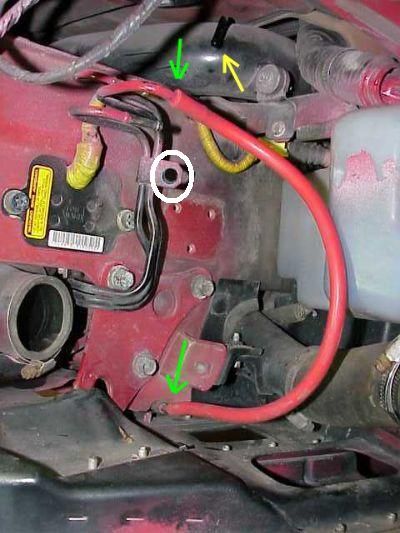 Tree is attached to outer front driver side frame rail with a bolt thru the white circle. Tree is attached to outer front driver side frame rail with a bolt thru the white circle.
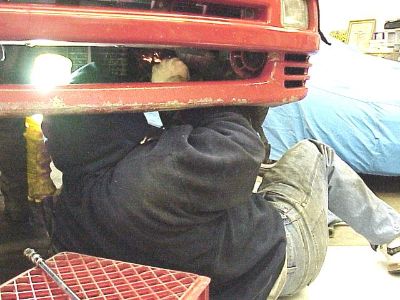 After the bolts are removed, the hardlines still need to be cut in order to wiggle them from from around the frame rail. Spence making sparks with the Dremel. After the bolts are removed, the hardlines still need to be cut in order to wiggle them from from around the frame rail. Spence making sparks with the Dremel.
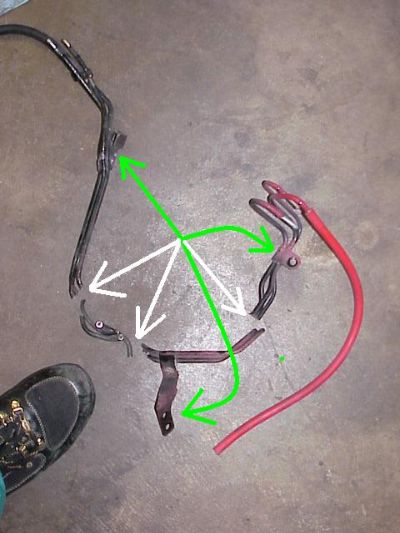 Here is the hardline tree cut out of the car. Green arrows show were bolts were removed, white arrows show cuts made with the Dremel. The original fuel vent lines on both ends are still in place. The entire length was replaced with a soft line. Here is the hardline tree cut out of the car. Green arrows show were bolts were removed, white arrows show cuts made with the Dremel. The original fuel vent lines on both ends are still in place. The entire length was replaced with a soft line.
We used some 5/16" fuel injection line we had on hand, but the line does not hold any significant pressure.
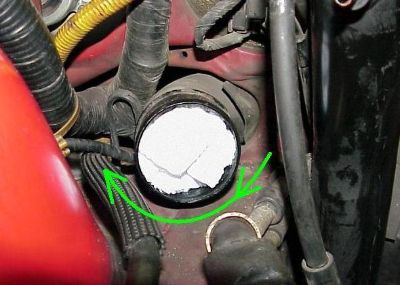 The vent line that was attached to the hardline in the engine bay was rerouted as shown. This yielded a more direct path to the fender well space. The vent line that was attached to the hardline in the engine bay was rerouted as shown. This yielded a more direct path to the fender well space.
Bypasssing the CC without removing the FF and comments about the 1996 Z with On Board Diagnostics II (OBD II)
Note that capping the nipples at the TB and the balance tube under the hood can be done in just a couple of minutes at ANY time without removing the front fascia. This temporarily BYPASSES the CC, which can be a very helpful, “quick and dirty” diagnostic tool for eliminating the CC and its connections as possible sources of vacuum leaks or trouble. The use of an inexpensive vacuum gauge could also be very helpful during this test, as you could compare vacuum readings before and after this temporary bypass of the CC. If you isolate the CC as a cause of a problem, then you know you have to fix it or eliminate it, before actually taking the FF off.
Why not just bypass the CC and leave the CC in place? I dunno, I suppose you could. You could cap the vacuum galley next to the IC hose where you pulled the lines to eliminate any chance of fume return. However, I would still be worried about the fuel vent line connected to the canister as a “dead end.” Without any vacuum source connected to it, the canister would eventually clog and then the fuel tank would be sealed and ventless, which doesn’t sound good. Perhaps that is not an issue but if you bypass the CC by only making new vacuum connections under the hood, then I recommend this only as a TEMPORARY diagnostic tool.
If you own a 1996 Z then your emissions control systems were impacted by the On Board Diagnostics II (OBD II) system. OBD Il periodically checks many emissions control functions not monitored by earlier years OBD. This check includes evaporative canister purge system and a fuel tank leak check.
A 1996 Z undergoing an OBD II check will NOT pass emissions testing if the EVAP system throws any of the error codes listed below. This does NOT effect the emissions as measured at the exhaust, but is simply an error code that states the EVAP system is not functioning properly, and therefore your vehicle could be releasing unburned gas fumes into the atmosphere. I do not know exactly how removing the CC in a 1996 Z throws error codes at the ECU or OBD II level, but I think it is fairly safe to assume that it does, especially when you see the OBD II error code possibilities below:
P1440 EVAP Control System (Small Leak) (Positive Pressure)
P1444 Canister Purge Volume Control Solenoid Valve
P1446 EVAP Canister Vent Control Valve (Close)
P1447 EVAP Control System Purge Flow Monitoring
P1448 EVAP Canister Vent Control Valve (Open)
P1490 Vacuum Cut Valve Bypass Valve (Circuit)
P1491 Vacuum Cut Valve Bypass Valve
P1492 EVAP Canister Purge Control/Solenoid Valve (Circuit)
Although the EVAP codes don’t cause any performance issues, they will keep you from passing emissions testing. Emissions problems need to be fixed before the code can be erased.
Click here to read some good counterpoints to this article.
| 